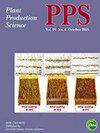Grain yield and genotype x environment interaction in bean cultivars with different growth habits
IF 1.3
3区 农林科学
Q2 AGRONOMY
引用次数: 7
Abstract
ABSTRACT Breeding of common beans (Phaseolus vulgaris L.) shows restrictions in the genetic advance because of the effect of the environment. Therefore, the behavior of the yield components of genotypes varies according to the crop’s environment. The genotype x environment interaction can cause genotypes with high yields in one location not to behave in the same way in other localities, which limits the recommendation of cultivars for different environments. The objective of this research was to evaluate agronomic traits in new improved bean cultivars in high tropic environments, as well as to determine which cultivars show phenotypic stability for yield. Multi-environment tests were carried out during 2016 and 2017 in two regions of the department of Cundinamarca, in Colombia. Significant differences were found for the genotype x environment interaction and highly significant differences for the evaluation environments and genotypes. The greatest variation was attributed to genetic effects, followed by environmental effects and the genotype x environment interaction. The first two principal components for grain yield showed 88.86% of the variation of the genotype x environment interaction. Cultivars Serrania and Sutagao, of climbing growth habit, were identified as stable and with high yield potential, so they can be considered as a commercial alternative for bean growers. Graphical abstract不同生长习性大豆品种籽粒产量与基因型x环境互作
由于环境的影响,菜豆的育种在遗传进展方面受到限制。因此,基因型产量组成部分的行为因作物的环境而异。基因型与环境的相互作用会导致一个地方产量高的基因型在其他地方的表现不一样,这限制了不同环境下品种的推荐。本研究的目的是评估高热带环境下新改良大豆品种的农艺性状,并确定哪些品种对产量表现出表型稳定性。2016年和2017年,在哥伦比亚昆迪纳马卡省的两个地区进行了多环境测试。基因型x环境相互作用存在显著差异,评价环境和基因型存在高度显著差异。变异最大的是遗传效应,其次是环境效应和基因型x环境相互作用。粮食产量的前两个主成分表现出88.86%的基因型x环境相互作用的变异。具有攀爬生长习惯的品种Serrania和Sutagao被鉴定为稳定且具有高产潜力,因此它们可以被认为是豆种植者的商业替代品。图形摘要
本文章由计算机程序翻译,如有差异,请以英文原文为准。
求助全文
约1分钟内获得全文
求助全文
来源期刊

Plant Production Science
农林科学-农艺学
CiteScore
5.10
自引率
4.00%
发文量
27
审稿时长
>36 weeks
期刊介绍:
Plant Production Science publishes original research reports on field crops and resource plants, their production and related subjects, covering a wide range of sciences; physiology, biotechnology, morphology, ecology, cropping system, production technology and post harvest management. Studies on plant production with special attention to resource management and the environment are also welcome. Field surveys on cropping or farming system are also accepted. Articles with a background in other research areas such as soil science, meteorology, biometry, product process and plant protection will be accepted as long as they are significantly related to plant production.
 求助内容:
求助内容: 应助结果提醒方式:
应助结果提醒方式:


